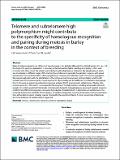Por favor, use este identificador para citar o enlazar a este item:
http://hdl.handle.net/10261/349364COMPARTIR / EXPORTAR:
 SHARE SHARE
 CORE
BASE CORE
BASE
|
|
| Visualizar otros formatos: MARC | Dublin Core | RDF | ORE | MODS | METS | DIDL | DATACITE | |

| Título: | Telomere and subtelomere high polymorphism might contribute to the specificity of homologous recognition and pairing during meiosis in barley in the context of breeding |
Autor: | Serrano-León, I. M.; Prieto, Pilar CSIC ORCID ; Aguilar, M. I. | Palabras clave: | Meiosis Barley Chromosome dynamics Genome organization |
Fecha de publicación: | 26-oct-2023 | Editor: | BioMed Central | Citación: | BMC Genomics 24: 642 (2023) | Resumen: | Barley (Hordeum vulgare) is one of the most popular cereal crops globally. Although it is a diploid species, (2n = 2x = 14) the study of its genome organization is necessary in the framework of plant breeding since barley is often used in crosses with other cereals like wheat to provide them with advantageous characters. We already have an extensive knowledge on different stages of the meiosis, the cell division to generate the gametes in species with sexual reproduction, such as the formation of the synaptonemal complex, recombination, and chromosome segregation. But meiosis really starts with the identification of homologous chromosomes and pairing initiation, and it is still unclear how chromosomes exactly choose a partner to appropriately pair for additional recombination and segregation. In this work we present an exhaustive molecular analysis of both telomeres and subtelomeres of barley chromosome arms 2H-L, 3H-L and 5H-L. As expected, the analysis of multiple features, including transposable elements, repeats, GC content, predicted CpG islands, recombination hotspots, G4 quadruplexes, genes and targeted sequence motifs for key DNA-binding proteins, revealed a high degree of variability both in telomeres and subtelomeres. The molecular basis for the specificity of homologous recognition and pairing occurring in the early chromosomal interactions at the start of meiosis in barley may be provided by these polymorphisms. A more relevant role of telomeres and most distal part of subtelomeres is suggested. | Versión del editor: | https://doi.org/10.1186/s12864-023-09738-y | URI: | http://hdl.handle.net/10261/349364 | DOI: | 10.1186/s12864-023-09738-y | ISSN: | 1471-2164 |
| Aparece en las colecciones: | (IAS) Artículos |
Ficheros en este ítem:
| Fichero | Descripción | Tamaño | Formato | |
|---|---|---|---|---|
| context-breeding.pdf | 6,38 MB | Adobe PDF |  Visualizar/Abrir |
CORE Recommender
PubMed Central
Citations
1
checked on 29-abr-2024
SCOPUSTM
Citations
1
checked on 08-may-2024
Page view(s)
15
checked on 14-may-2024
Download(s)
3
checked on 14-may-2024

